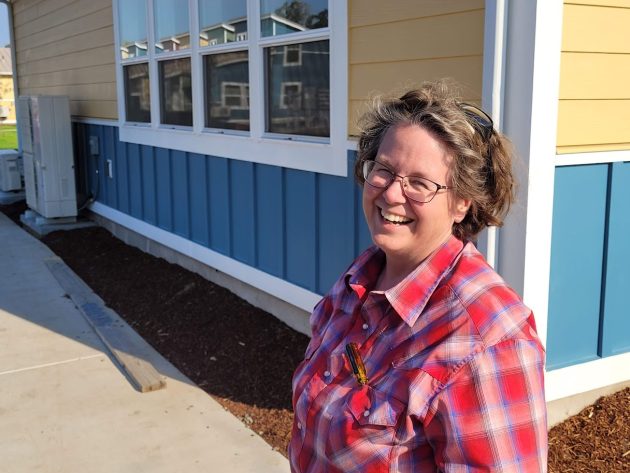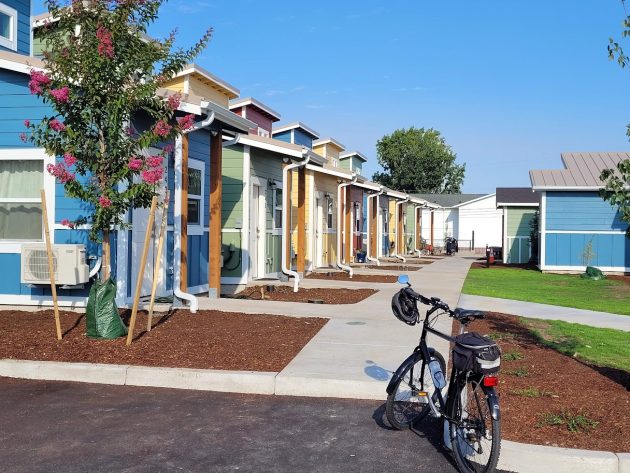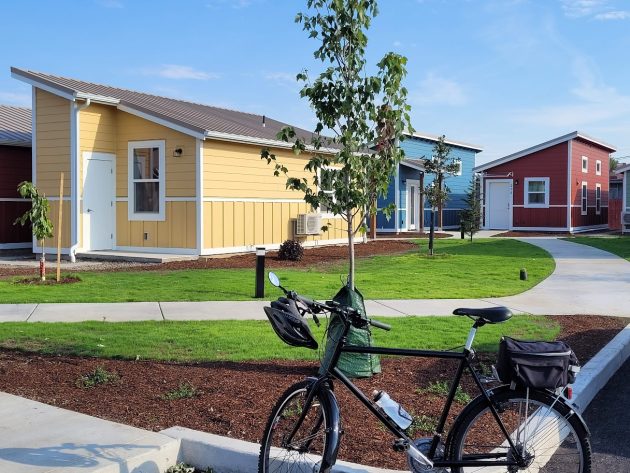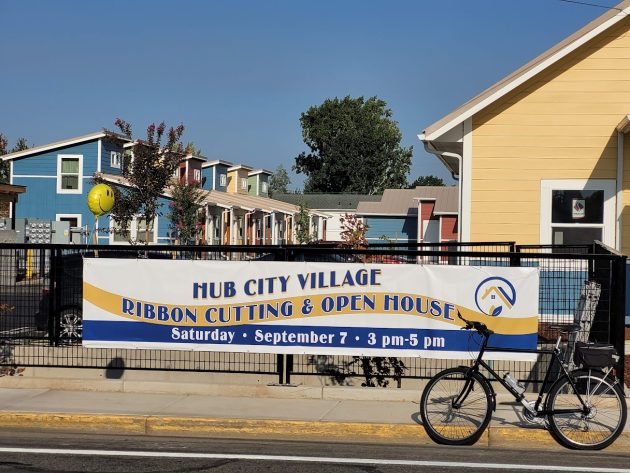
Stacey Bartholomew, president of Creating Housing Coalition, at Hub City Village on Saturday evening.
It was five years ago, in July 2019, that leaders of a new nonprofit in Albany were telling me about their plans for Hub City Village. Now they’re about to celebrate reaching their goal.
In that first story after talking to them, I wrote:
How about this: A community of small cottages, each with room for one or two people, clustered on maybe an acre or so, with rents low enough that some of Albany’s residents with very small incomes could live there without fear of being thrown out on the street?
The main point I took away from our chat is that theirs is not some half-baked dream of a bunch of starry-eyed do-gooders. No, they have a concrete, detailed plan that has worked elsewhere. They realize they can’t cure homelessness in Albany, but they intend to do something, something that will actually work for at least a few people whose main problem is that they haven’t been able to afford a place to live and face all kinds of issues as a result.
On Saturday, Sept. 7, the public is invited to see what they have accomplished. Hub City Village, 241 Waverly Drive S.E., will hold an open house from 3 to 5 p.m.
I stopped by the place on a bike ride Saturday. Construction and landscaping are as good as complete.
Stacey Bartholomew was there. She’s the president of Creating Housing Coalition, the organization behind this community of 27 colorful “tiny houses.”
Twenty of the houses are occupied, she told me. The rest, as I understood it, still needed city clearance for occupancy. (On its website the coalition says resident applications for this year are no longer being accepted.)
I asked Bartholomew about the final cost. “Five point seven,” she said. That’s $5.7 million. The nonprofit raised the money from government grants and donations.
But they couldn’t have completed the job without volunteer help. About 40 volunteers did a great deal of work in getting the houses and the landscaping ready.
I walked around the grounds for a bit. It looks like a nice neighborhood in which to live. If you attend the open house, you can see for yourself. (hh)

A row of larger units with a loft at Hub City Village.

More units in the center of the development.

On the fence, Hub City’s announcement of the Sept. 7 opening ceremony and open house.


Dear Hasso,
Life changes and it doesn’t seem for the better. Susan Tedisch
It appears a significant portion of the $5.7 million in funding came through federal, state, and city grants awarded to CHC.
In the interest of transparency and full disclosure to taxpayers, can someone from CHC provide a breakdown of how much came from each government grant?
It would be helpful to understand how much was voluntarily given to CHC by private donations versus how much was transferred to CHC via public taxation.
I agree! How much of this $5.7 million come from tax payers?
Hasso, in your post dated Jul 31, 2019, you asserted, “The place would be self-supporting without direct subsidies from taxpayers.”
In your post dated Jul 31, 2024, you quoted Bartholomew, “We hope the city will consider providing financial assistance to organizations like ours.”
Finally, in this post you quote Bartholomew again, “The nonprofit raised the money ($5.7 million) from government grants and donations.”
Clearly Bartholomew has changed her tune.
Is CHC only sustainable into the future with public money?
If yes, Bartholomew needs to come clean and admit the dependency to taxpayers/private donors now.
If yes, and I’m a private donor, my motivation to donate to CHC in the future just went down quite a bit.
But you’re not Gordon, because you live on the east coast, not Albany.
Just to be clear, projects that catch the spirit of private voluntary associations and volunteerism are inspirational. Free association and volunteerism are threads that should be knitted deeply into a community.
But these threads became frayed when project leaders do what they evidently promised they wouldn’t do – use taxpayer money.
Creating a dependency on future taxation is not sustainable for a non-profit corporation.
Thank you for the update Hasso. I hope to make the open house so I can see what the group accomplished.
These houses are nice but it took 5 years and how much of that 5.7 million was used for administration costs (wages for five years etc.). How many people during that time were kicked out of their homes for lack of funding for taxes, repairs and disability? Home retention would have saved way more people from homelessness and in less time than 5 years. Without home retention the homeless people created by conditions beyond their control will continue to increase. Stopping people from becoming homeless is the only way to get it under control. All the money spent is filling a bucket with a hole in it. There are only are about 52 people smiling about the building of these houses and the people who had job security and at no risk of becoming homeless for 5 years while the project was being completed. Hundreds of Oregonians have lost their homes in the last five years. That money could have saved all of them.
You are right.
Yes “That money could have saved all of them.” And would have improved the lives of the rest just of us by dint of less taxation overall. If we could only create less homelessness than the current rate. California seems a great example of what not to do….and I continue to beat the drum about our own city adding to our utility bills without a vote.
I think it would be wise not to allow this…unless you think the City can be trusted access to your wallet, and there’s no mechanism to control their “dipping in” repeatedly.
Taxation without representation…it seems to be in obvious violation of such.
No you are NOT right. That money was spent clearing land, designing houses, building, landscaping, permitting etc. the Exec Dir Stacey and the board have WORKED for free. They are volunteers. They have spent 100’s if not 1000’s of their personal hours giving to this project. They have recruited many joyful volunteers to help then made bed frames and tables, curtains and quilts. They have cleaned and planted. Put up curtain rods and curtains. Watered and washed construction dirt away. The list goes on. as volunteers we feel blessed to see the success of this project. Come join us if you can.
So many had negative things to say when this coalition got started. But they’re positive attitude and hard work prevailed.
Not to worry Katherine…
The CHC folks have done a masterful job marshalling their project from start to now opening. Kudos to them!
(It’s normal for the usual troglodytes & boll-weevils to surface whenever anything positive happens…)
This is a first! I agree with you, Ray.
Stuff happens… Who knew? :-)
Because sometimes only the hardiest of trolls (Gordon) can be so negative in the face of positive change.
Five million, seven hundred thousand dollars for twenty-seven housing units equates to $211,111,11 each. At current 30-year fixed mortgage rates of 7.25% the monthly payment is $1,440 for qualified borrowers. Unless these units are somehow subsidized it seems there is no great cost savings compared to renting an apartment of similar size.
You cannot rent an apartment for $1,440. They start at about $1,700 or $1,800 for a studio with a murphy bed. It’s obscene what prices are now because of price gouging.
Yes I agree!
The floor plans on Hub City Village do not include measurements. I am going to guess less than 900 sq ft.
While I commend the work that has been done. We the public desperatly need a solution to the homeless. This is not that solution.
If they can improve upon the process and cut the price to 1/3, then maybe.
From what I see, the architecture, color scheme, and landscaping are vastly more attractive than conventional housing neighborhoods I see being built. Nice work!
It does look like a nice neighborhood in which to live… but don’t tell anybody! ;)
Thanks again for your local news coverage Hasso.
One nods his head.
Up and down. NOT left or right.
Sending positive vibes. GOoooooooo!
This is so awesome and so darn cute!
I hope there’s going to be an application process that prevents drug/alcohol users from renting and eventually ruining this darling development.
my question? if we had 5000 of these available, would we see less homeless people in albany?
I will speculate that we would see a few less homeless in the area, but even with five thousand more units of this type the homeless population would not be significantly diminished.
The sad truth is that for many people living on the streets is a lifestyle choice.
Julia, We know people who have lost everything. No one made them curtains, beds etc. Their stuff was all hauled away when they lost their homes that they lived in for 15 or more years. Where were all those joyous volunteers then? Their lives were ruined for a mere fraction of what is spent on one of these tiny cottages. Being a cheerleader for these “much ado about nothing” time and money consuming projects have not benefited any of those people that were hard working people that suffered immense losses is an affront to them. Peddling these types of solutions are like giving someone a band-aid for a broken arm. Sometimes people need more than just kissing their boo boo.
A friend is supposed to be moving in there. She may have already done so. She told me the tenants must be employed. Of course they cannot “make too much $). She has sofa surfed for years after her divorce. She will finally have a home. However, the cost of $211,111 is way high. Mr. Kopczynski, can you tell us how much of that was attributed to SDC charges per dwelling and permit fees?
The cost of government fees is responsible for a large percentage of the cost to build a home. These tiny houses look to be about 600 sq ft. The project does look very nice. But I, as a taxpayer, am tired of our very hard earned $$ going to pay for these projects. Unfortunately, business owners and small corporations, that for years have made various donations are finding it harder and harder because the State Legislators are looking for ways to tax those very bad corporations. It’s time for the tax tax tax madness to stop.
From City Staff:
“As these are built just like a single family home, each tiny home has its own permit and associated fees. In general the total fees per unit were about $8,100. Of that approximately $7,100 is attributable to SDC’s, the remainder $1,000 being for the building permit and planning review.”
So the City raked in almost two hundred and twenty thousand dollars on this project designed to assist desperate people in need, financed by private philanthropic and taxpayer funded grant donations?
West Albany Res, My kiddos see all the token efforts the city makes “helping people” while spending huge amounts of money on these projects that just help a few people and wonder why people support them. This includes all the other smaller projects such as the homeless camp and continued support of helping hand’s useless ideas to waste more money. Every time these projects don’t work they propose another half-baked idea to get more funding. Please stop supporting these projects. Holdout for more substantial and viable solutions that are a long term help for more people such as helping them before they are homeless.
Who pays the yearly property taxes on these ? Just curious.